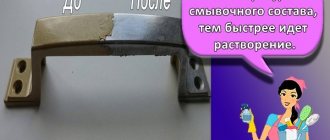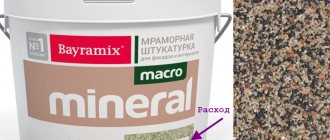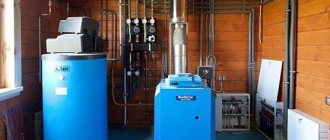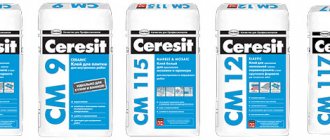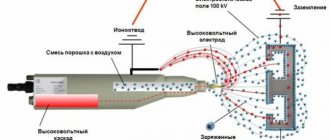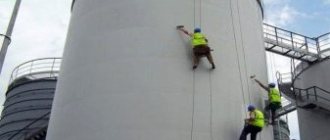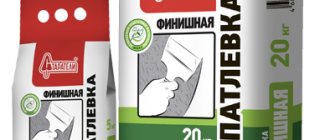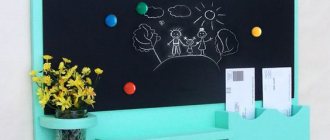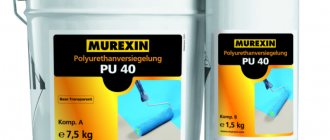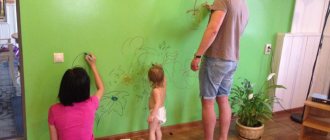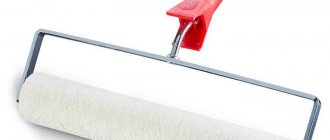Possible problems and their solutions
Various difficulties may arise when using powder pigments.
Technologists believe that the main cause of problems with powders is insufficient grounding of the surface prepared for painting. To avoid difficulties with grounding, it is recommended to check it in advance. The resistance value should not exceed 4 ohms. Poor grounding leads to the following consequences:
- Deterioration of sediment quality, decreased productivity of painting work.
- Failure to paint areas, causing defects.
- Increased powder losses leading to overconsumption.
- Deterioration in the quality of the formed layer, obtaining a “crust” effect, which implies translucence of the metal, and a tendency to develop cracks.
- Hand dyeing may result in electric shocks.
Many users note that they have problems with the material intended for work. Damp powder paint can clump, clog nozzles, and flow incorrectly onto the spray gun. This leads to the creation of an uneven layer, suspension of work or the creation of a defective zone.
Raw powder clumps if storage rules are violated or conditions are created for poor-quality air compression when starting work. To correct the situation, it is necessary to change the air compression indicator. Changing the pressure will stop the material from deteriorating.
Failure to paint the internal corners of parts with complex configurations is a problem that arises as a result of incorrect torch position. Approaching the gun muzzle too close to the corner being processed leads to blowing off of the powder, the formation of unpainted areas, and the appearance of gaps.
How to paint metal?
Suitable products are the key to success, so when working with metal bases, this factor plays the most important role.
Universal materials
Painting can be carried out by the following common types of products:
- Epoxy. For the manufacture of such compositions, silicone resins are used, which are supplemented with a hardener. Due to their high toxicity, they are used only for outdoor work. They differ in the complexity of application.
- Oily. A traditional option based on organic matter. Before treatment with this composition, the metal is pre-coated with primer. Due to the toxicity and pungent odor, parts can only be painted with good ventilation.
- Alkyd. They are in constant demand in cases where metal products need to be processed. Suitable for indoor and outdoor events. If the base is well prepared and has no problems, then the composition can be applied without prior priming.
- Acrylic. A modern polymer-based variety. Non-toxicity and ease of application make the material popular. The composition is suitable for painting metal surfaces subject to careful preparation.
- Rubber. Used for outdoor use, excellent for roofs or areas exposed to precipitation.
Rubber paint for metal is often used to finish galvanized roofing.
These solutions are considered classic and are used everywhere. The powder painting method stands out separately. It is complicated in that it requires the use of special equipment and tools.
Specialized options
To ensure reliability and durability, in some cases special materials are required:
- Compositions used in the presence of rust. They are an epoxy variety with special additives. They create a reliable film, preventing further destruction. They are applied without pre-treatment of the base directly to rusty areas.
- To prevent corrosion. Such materials provide the surface with additional protection from moisture and oxygen, that is, they do not allow parts to rust.
- Hammer compounds. They form an interesting decorative coating, reminiscent of traces of multiple hammer blows. They have good stability. Various base options are used for production: epoxy, acrylic, alkyd.
- Primer-enamel. A universal type of product that combines primer, corrosion protection and paint.
- Forging mixtures. Their production involves polymer compounds, which gives the coatings excellent wear resistance. Demonstrate good adhesion.
- Nitro paint. Sold in cans. It is highly toxic.
There are other types of coloring mixtures - varnish and enamel, which are used in the processing of stoves and other similar products. They belong to heat-resistant materials.
Powder paint consumption per 1m2
Painting involves applying a powder dye to the object to be painted. The material dissolves under the influence of polymerization, due to which it is able to evenly cover the object being painted.
The powder coloring agent is applied only once, since its layer is the same thickness as 3 layers of any other coloring agent.
Its big advantage is durability - the painted object receives maximum protection from external influences, such as temperature changes, chemicals, corrosion and mechanical damage.
You can find a wide range of powder paint mixtures, including polyester-epoxy and polyester paints. When choosing, you should consult a specialist who can select the quantity and composition based on your needs.
It is worth choosing powder coating because its properties are superior to traditional paints. Powder painting is suitable for painting small metal objects, such as:
Powder paint consumption information.
- gates;
- ladder;
- railings;
- accessories and auto parts;
- alloy wheels;
- bumpers for SUVs;
- bicycle frames;
- car parts and car bodies;
- Appliances;
- electrical equipment housings;
- racks;
- radiators;
- lamps;
- façade elements;
- gutters;
- window sills;
- metal garden furniture.
The average consumption varies within 140 grams per square meter. But it can differ significantly from the original one under the influence of various factors, including the size and shape of the surface, its evenness, the method of application and the type of coloring matter.
- Size. First of all, it is necessary to calculate the area of the surface to be painted. If the surface has curves, the flow rate may increase.
- Evenness is an important factor when calculating material consumption. The smoother the surface, the less paint will be needed. Therefore, before painting the product, it is necessary to sand it to a shine.
- Method of application. Experts advise applying paint using a spray gun. This application method allows you to reduce the amount of material used by almost 2 times.
- Variety. Consumption depends on the type of paint. Manufacturers indicate the consumption and weight of the coloring composition on the container in which the paint is located. If you follow all the rules when painting objects, the consumption will differ little from that indicated on the packaging by the manufacturer.
Consumption of PF-115 paint per 1 m2 for metal
The abbreviation “PF” in the name of the enamel means PENTAFTHAL. It’s easy to decipher – the paint material contains alkyd resins and semi-dried oils, which allow the paint to dry quickly.
Enamel PF 115 occupies a leading position in the market of paints and varnishes. If we describe it in one word, then the most appropriate one would be “versatility.” Used for painting any type of surface. The paint can be mixed with other compounds, as well as with a primer.
Consumption rates of PF-115 per 1 m2
As practice shows, the rate of material consumption varies from 100 to 180 g. Also, professionals say that on average a can weighing one kilogram is enough to paint 15 m2 of prepared surface. Also, the consumption of PF 115 directly depends on the selected color pigment.
Below is a table of the approximate consumption of PF-115 enamel (depending on the selected color):
| Color | How much area is 1 kg of paint enough for? | Paint consumption per 1m2, g |
| White | 7–10 m2 | 100–140 g |
| Yellow | 5–10 m2 | 100–180 g |
| Green | 11–14 m2 | 70–90 g |
| Blue | 12–17 m2 | 60–84 g |
| Brown | 13–16 m2 | 63–76 g |
| Black | 17–20 m2 | 50–60 g |
You can reduce the amount of coloring composition if you choose a silicone-based roller to apply it.
When working with powder paint
After passing through powder coating equipment, the products obtain excellent decorative and anti-corrosion properties. The material savings here are almost 100% (paint that has not settled on the surface can be used again). Modern lines of equipment for powder coating and decorative finishing of metal are fully automated.
Among the advantages of powder over enamels, they note the greater strength of coatings to mechanical stress (for impact - 100 kg/m, for bending - 4-6 mm). It is also worth mentioning the increased adhesion (adhesion of the powder to the surface - 500 kg/nm). The coating improves the anti-corrosion characteristics of the product. It can withstand solutions of alkalis, acids and organic solvents.
Items painted with powder paint can work in the range of -60°C… + 150°C. The thickness of the coating can be from 0.05 to 0.3 mm. The produced paints of this type are available in all colors according to the RAL map. Based on the type of film formation, they are divided into several main groups:
- epoxy;
- polyester;
- epoxy polyester;
- polyamide.
With their help, glossy and matte surfaces can be formed.
Working with powder is more environmentally friendly because it does not release vapors of liquid solvents. Equipment for powder coating does not require preliminary priming of products. To apply the coating, it is enough to pass the products through the painting line once.
This method provides production with a reduction in overall energy costs by 20-40%. The dyeing process becomes faster and less labor-intensive. It is almost completely safe for personnel and does not require spacious premises. The conclusion is obvious: powder paints are more profitable to use than liquid paints in many respects.
Factors affecting paint consumption
Paint consumption per 1 m2 depends not only on its properties, but also on what surface it will be applied to. This factor often becomes decisive in the calculation. By indicating certain consumption rates on the label, the manufacturer usually means that the paint will be applied to a surface that is not too porous. In practice, it often happens that the wall being treated, for example, absorbs the product very strongly. As a result, it takes a little more. Usually in such cases it is necessary to paint the surface in several layers. This applies, for example, to materials such as wood and concrete. When painting metal and plastic surfaces, of course, less product will be used.
Thus, paint consumption per 1 m2 depends, first of all, on the type of composition itself, as well as the type of surface being treated. In addition, this indicator is significantly influenced by which tools will be used during the work process. So, when painting with a brush or roller, paint is consumed somewhat more than when using a sprayer. Much in this regard depends on the skill of the person performing this work.
Attention, TODAY only!
Everything interesting
Today, many people increasingly prefer painting their walls rather than paper wallpaper, which tends to get dirty and peel off. At the same time, they often do not know which paint is best suited for interior work, since the range of modern…
There is a large selection of paints designed for external use. Before applying them to the fence, it is recommended to coat the surface of the wood with primer compounds. This will significantly increase the service life of the coating. The most accessible material for…
The market for paints and varnishes offers a wide range of products from Russian and foreign manufacturers - oil paints, acrylic, silicone, silicate, water-based. When choosing paint, you need to consider the conditions...
Wallpapering walls is a common type of decoration. They are used for any room in the apartment, since you can choose from a wide variety of textures and colors. Modern wallpapers are divided into several groups. You can paint paper, non-woven,…
In modern construction, colored concrete is very often used. They can be obtained by using various pigments and dyes. Thus, concrete can be given almost any desired color. Colored concrete has excellent…
At the moment, when carrying out repairs, builders are increasingly using latex paints. And this is not surprising, because latex paint has a number of advantages over regular paint: it is environmentally friendly, allows you to work in a confined space, does not…
Protective paint is a building material that is applied to various surfaces not only to give them a rich color and mask possible imperfections and deformations, but also to protect them from mechanical stress and environmental influences...
Paint is a material that is used to impart color to certain objects. Enamel is a thin layer of glass that is applied to the surface and subjected to high-temperature treatment. Paints and enamels have different properties. ...
Acrylic paints are made from water and an acrylic pigment binder, which form a bright and durable film after drying. Due to their versatility and ease of application, these paints are gaining increasing popularity and are used as…
During renovations in your apartment, you most likely encountered the problem of calculating the amount of construction and paint materials. Armed with a calculator, pen, piece of paper and basic math knowledge, you...
Powder paint is a solid mixture of small dispersed components. In production, resins are additionally added to them, which have the ability to form a film on the surface of the painted products. Also, pigments are often added to them to obtain the desired shade and hardeners, which allow them to harden in air. There are also certain types of additives that give them the properties necessary under certain conditions.
There are two main groups of powder paints in the world. They are defined by their ability to form a film on a particular type of surface.
All powder paints are divided into:
Thermoplastic powder paints
These dyes are based on thermoplastic components that form films on the surface of the object being painted without the method of chemical interaction with it. The film is formed as a result of the melting of paint components and their subsequent cooling. The resulting films can melt after being heated to high temperatures.
Thermosetting powder paints.
The composition of this group of paints is the same as before use on the surface. This group of dyes includes polymer powder paint. It is based on a component such as polyvinyl butyral or polyvinyl chloride.
Powder paints are often used to protect surfaces and give them an attractive appearance. In most cases today, polymer powder paints are used, which give surfaces a rich shade and are excellent for treating walls and other indoor objects. In the modern world, the scope of application of powder paints is quite wide. They offer great opportunities for decorative finishing of external facades of buildings and are ideal for carrying out renovation work indoors.
The main technical characteristics of powder paints are:
- Dispersion composition
Any type of paint of this kind contains many particles. Depending on the type of powder paint I have assigned, their size may vary.
- Flowability
In the modern world, a large number of requirements are placed on all powder paints. One of them is the presence of good flowability. All paint particles should be dry and easy to separate from each other.
- Hygroscopicity
Any powder type paint should have the ability to absorb liquids well. When interacting with water, paints lose their ability to crumble easily, which affects their quality.
- Bulk density
This unit of measurement for the quality of powder paint is determined by how much of it is needed to completely cover a surface measuring one square meter. The norm is 800-1000 grams per square meter.
- Fluidization
This property means that after applying the paint, a fluidized layer is formed, which is necessary in order to properly coat the material.
Important:
The average consumption of powder paint per 1 m2 is approximately 100 grams per square meter. Depending on its type and the thickness of the coating, its size may vary.
The color palette of powder paints is quite large. It makes it possible to choose any shade for painting objects. RAL powder paint helps you choose the most optimal shade. This scale is useful in choosing the right color to paint any item.
In the modern world there are a large number of companies that specialize in the production of different types of paints for all types of surfaces. Many of them produce large volumes of powder paints, which are very popular today.
The production of powder paint is a complex process from a technological point of view. To do this you need to have specialized equipment.
Each powder paint production plant has spiral conveyors. They are connected to belt blenders, where particles of the substance for the future powder are ground into very fine crumbs. Depending on the type of powder paint, the particles can have different sizes. During the production process, the ground particles enter the tank. Next they are sent for packaging. As a result, consumers have the opportunity to purchase powder paints in the required volume.
Required materials and equipment
So, let's give a detailed description of the technology of powder coating of metal. To create a durable coating layer on it you will need:
- oven (chamber) for polymerization: you can make it yourself or purchase it in a specialized store;
- spray gun: since such a device costs a lot, it can also be assembled from a converter, often used in lighters for gas stoves, a power supply and an ordinary plastic bottle;
- naturally, the paint itself.
Drying ovens will need to be connected to a voltage source of 25 kW. In operation it will produce 6 kW, while warming up a little more - 12 kW. To make it, you will need thick sheet metal for the housing, heating elements, a tangential fan in which air masses will move in one direction, as well as any non-flammable heat insulator for the casing.
The heating elements are placed parallel to each other on opposite walls of the furnace. The main part of the fan is mounted outside the chamber. It is welded in such a way that the exit is narrow and the entrance is wide enough. It is also necessary to make a separate chamber for spraying in the drying oven. For processing large parts, it is better to provide rail-type trolleys.
Methods of working with powder paint
Although the powder coating method has been known for quite some time, its technical development began relatively recently. During this time, several ways to carry out the process have emerged.
- Electrostatic spraying is considered the most popular and widespread. The principle is that powder particles acquire an electrical charge as they pass through the atomizer. In this case, the treated coating remains electrically neutral. It is this difference that creates an electric field, due to which the powder is attracted to the surface and held firmly. This is the first stage of painting. Next, the processed part is placed in a special oven, where it is heated at a temperature of about 200 degrees. Short-term exposure melts the top layer, and it is reliably absorbed into the base. The electric charge gradually disappears.
- A more complex method is one that involves preheating. That is, the metal product being painted is heated to a certain temperature (the indicator is selected individually). Using a sprayer, powder paint particles are applied to the base and melted. Further actions do not always involve reheating and depend on the type of coating applied.
- For the third option, predominantly thermoplastic powder is used. The work uses a special spray tool, which is equipped with a chamber with burning propane. Preheated particles hitting the surface form a durable protective layer. Although this technology allows the coloring of various materials, its distribution is relatively small.
The demand for the first painting method is explained by the fact that this option has greater technological development. With other methods, everything is more complicated: the second method requires careful selection of temperature, and the third appeared relatively recently.
Powder paint brands
In the modern world, various manufacturers produce a large number of powder paints. Pulver powder paint has gained great popularity due to its high quality. The palette of its shades on the ral scale is quite large. The pigmentation of the dyes of this Turkish brand is excellent. Ultimately, this leads to savings. After all, it takes very little paint to cover one square meter.
Among the domestic brands, Akzo Nobel powder paint is well-known. Paints of this brand are distinguished by the fact that they do not contain the addition of solvents, which makes them suitable for use on a wide variety of surfaces. They have protective properties. They are often used for painting radiators and pipes.
Powder painting is carried out in three stages.
They are:
- preparing the surface for applying a layer of paint. At this stage, it is necessary to remove large and small contaminants from the surface and thoroughly rinse and dry everything.
- applying powder paint. At this stage, it is necessary to spray a thin layer of paint over the surface so that the subsequently painted layer is uniform. For this purpose it is necessary to have specialized equipment. It can be represented by a special pneumatic device.
- polymerization. At this stage, the product coated with powder paint is sent to a special oven, where it is heated.
Table 1. Surface preparation before applying powder paint.
| Coating defects | Causes | Remedies |
| Contamination of the coating | Presence of large inclusions in the original paint or paint coming from the recovery system | Replace or sift paint; check paint return sieves |
| Contamination of the air supplied to the spray or heating device (oven) | ||
| Shagreen | Low paint flow rate (possibly due to exceeded shelf life) | Replace paint |
| Low coating formation temperature | Raise oven temperature | |
| Very thin coating | Increase thickness by adjusting paint supply | |
| Craters | Paint non-compliance with the requirements of NTD | Replace paint |
| Poor air purification from oil contaminants | Improve the quality of air purification | |
| Poor cleaning of products | Check appropriate chemicals and equipment | |
| Bubbles, punctures, visible micropores | Defects in the surface to be coated (presence of pores, craters, air cavities) | Apply paint to a preheated product |
| Coating formation temperature is too high | Reduce oven temperature | |
| High moisture powder | Check storage conditions | |
| Gas evolution during polymerization reaction | Maintain coating thickness no higher than 100 mm | |
| Drips | Excessive paint bleed | |
| Applying an excessively thick layer of paint | Reduce the thickness of the applied paint layer | |
| Color change | Excessive temperature or coating formation time | Align coating formation parameters |
| Poor cleaning of the installation when changing from color to color | Ensure cleanliness of all installation elements | |
| Increased shine of matte finish | Paint applied too thin | Increase the thickness of the applied paint layer |
Calculating the consumption of powder paint per 1 m2 is quite simple. To do this, you need to take two quantities: the weight of the coloring matter and the thickness of the layer applied to the surface. The latter indicator should be less than 80 microns. To reduce the consumption of powder paint, you should use high-quality installations for application, with which, if used correctly, you can achieve a minimum consumption of about 120 grams of substance per 1 m 2.
Home painting - technology for working with powder paints
Preparation stages:
Cleaning. Any method necessary for a particular case is suitable:
- mechanical - with a grinder, brush, rag...;
- chemicals (solvent, acid, alkali);
- To remove rust, you can do abrasive cleaning (in a sandblaster) or treat the surface with a special compound (metal cleaner).
Primer with inorganic paints. A conversion layer is applied - protection against moisture, air, and dirt getting under the film.
Passivation. The product is treated with a sodium compound, chromium 3 nitrate or phosphated, which prevents secondary oxidation of the metal.
The last step in preparing for painting is to rinse, dry and cool the part. The product is ready. You can start painting.
In a special spraying chamber, dye powder is applied to the object being processed, which must be grounded, for which an electrostatic gun (spray gun) is used. The part must be positioned so that it can be accessed from all sides. Due to the difference in electrical charges, dry paint particles “stick” to the surface of the workpiece.
The next stage is baking and polymerization of the paint. The painted product is placed in the oven. The main process will take place there - melting and formation of the film layer. The processing time and temperature depend on the composition of the dye. They must be indicated on the packaging. The material of the product being painted and the conditions under which it will be used are also taken into account.
The last point is that the product must cool completely.
Application technique
The surface for applying powder paint must be dry and clean, free from grease, rust and traces of old paint.
A durable and high-quality coating can be obtained with precise and consistent painting technology:
- Products prepared for painting are placed in a sealed painting chamber.
- Using a pneumatic tool, particles of positively charged dry powder are applied to metal surfaces with a negative charge using the electrostatic spraying method.
- The product to be painted is moved into the polymerization chamber, where under the influence of high temperature, about 120-180°C, the paint polymerizes. Powder particles melt and form a uniform film, which hardens when cooled. type, technical and operational properties.
How to paint with powder paint
After all the equipment has been assembled, purchased and adjusted, you can paint the metal parts yourself.
Paint selection
Powder paints are divided into two categories:
- Thermoplastic. The principle of obtaining the coating is that the powder is applied to the part that is being baked. The created layer is only affected by temperature. This group includes compositions based on polyvinyl butyral, polymers, polyamide, and polyefin.
- Thermosetting. The essence of the process is that fusion is accompanied by a certain chemical reaction. This allows you to obtain a surface that is resistant to any impact. Options for such mixtures: epoxy, polyester, epoxy-polyester, polyurethane.
Please note that the color of the selected paint is not tinted.
Both thermoplastic and thermoset compounds come in a wide range of colors
Dyeing technology
Housework requires the creation of certain conditions. All processes are distributed across areas to prevent disruption of the painting technology due to dust and dirt.
Procedure:
Metal processing is carried out. The surface is thoroughly cleaned of the old layer. If traces of blackening or bluing are observed, the coating must be completely removed.
Cleaned parts are degreased and thoroughly dried. If required, phosphating is carried out. Areas that do not need to be painted are covered. The processed product is placed in the spray booth and grounded. To do this, it is hung on hangers. Hooks should not interfere with the uniform distribution of the composition. Using a gun, powder is sprayed onto the surface of the part.
Care must be taken as the composition can be easily rubbed off when touched. If this happens, a new coat will need to be applied.
For this, the best solution would be to have a mobile attachment.
After processing, the product is placed in the oven. The required temperature regime is selected, the heating process lasts from 10 to 30 minutes. To paint the product correctly, you need to observe the temperature for each layer: if a primer is applied, then it is about 150–160°C, for a base coat – 170–180 degrees, and for a base coat – more than 190°C. Naturally, the indicators depend on the material and size of the part. After baking, the product is removed from the oven. For complete adhesion of the paint, it is recommended to wait a day.
Naturally, to obtain the optimal result, it will take some time to correctly configure all the equipment and develop a clear sequence of the technological process. But if all conditions are met, the result will exceed all expectations.
Powder paint production
The manufacturing technology includes several interrelated stages.
- Checking the raw materials - visual inspection, checking the markings with the actual contents.
- Dosage of components followed by transfer for mixing.
- Mixing is carried out in a mixer equipped with a cooling system.
- Melting the mixture at temperatures of 110-130°C and mixing it until it becomes a homogeneous liquid occurs in an extruder.
- Formation of a 1.5 mm thick tape from the melt.
- Grinding of the tape in a crusher in two stages with the rejection of particles whose fraction does not meet the standard.
- Multi-level quality check.
- Packing.
This material is usually used by large enterprises, so it is packaged in large containers - up to 600 kg.
Required Equipment
In order for the process of self-painting to be practically no different from the factory one, it is necessary to choose a suitable place where the work will be carried out.
When the premises have been found, you need to collect and prepare the necessary equipment:
- oven for polymerization (drying);
- constant voltage source (about 25 kV);
- powder paint sprayer (gun);
- LMB.
Accuracy and a little experience will not hurt in the work. But if it’s not there, it doesn’t matter; by following the instructions, you can avoid most mistakes and get quite a decent result.
Making a furnace
Polymerization is an important step in the hardening of powder paint. If this item of work is omitted, the paintwork will not adhere to metal surfaces. Therefore, equipment such as a furnace - also called a polymerization chamber - is necessary first of all. This thing is expensive, so you can make it yourself, from scrap materials. We will need (the polymerization chamber will have dimensions of 2x1x1 m):
- profile pipe;
- non-flammable thermal insulation (basalt slab);
- sheet metal (can be ordered by size);
- tangential fan;
- Heating elements.
The oven assembly instructions consist of the following steps:
- Weld a frame from the profile.
- Put insulation in it.
- Cover the walls with sheet metal. Finish the outside with gypsum fiber.
- For convection in the chamber, install a tangential fan, welding it with a narrow outlet and a wide inlet.
- Insert the fan into the chamber. It will take in air at the top, drive it through the heating elements, expel it at the bottom, and then distribute it throughout the entire volume of the chamber.
- Install the heating elements along parallel walls and connect them according to phase distribution.
- Close the heating elements, leaving the fan open, the main part of which should be located outside the chamber (so as not to melt the winding).
- Install an electrical panel. True, it is better to entrust this work to a specialist.
The resulting equipment - a polymerization chamber - will have a power of 12 kW when warming up and 6 kW in operation.
Important! The energy source in such ovens for drying powder paint can be not only electricity, but also natural gas and diesel fuel
Painting tool - gun
To apply powder paint to a product, a special device is required. This is an electrostatic spray gun or a tribostatic powder spray gun. But buying expensive equipment for rare use is not advisable. Since in our case everything is made by hand at home, such a device can be made in about 10 minutes. Such a gun is easy to use, cheap and practical. The transition from one paint to another takes a few seconds.
Design and equipment of a gun for powder paintingHow to make a powder paint gun:
- Take a regular plastic 1.5 liter bottle. The main thing is that it is dry and clean.
- Fill it 1/3 with powder paint, screw it with a metal plug.
- Make small holes in the cork. The more holes, the better the application. Clean the outside of the plug from any burrs left after piercing.
- Connect the positive wire from the high-voltage source to the plug.
For this purpose, you need a converter that can deliver 25,000 volts DC. These are used in stun guns, lighters for gas stoves, boilers and speakers. They can be powered by batteries or accumulators, converting 3-6 volts into the required 25 kV.
Use caution when working with high voltage. It is better to have the converter assembled by a qualified electrician.
After all the manipulations, you get a pretty decent pistol.
Little things you can't do without
Before starting painting, you need to carefully ensure that all operations take place under ideal conditions:
- Excellent lighting is essential. Use fluorescent lamps. Powder paint adheres perfectly to a regular lamp.
- You need good ventilation with two motors (inlet and outlet). Additionally, you will have to wear a gauze bandage, or better yet, a professional respirator.
- We will have to invent a way to collect the remaining powder paint. In the initial stages, use an old powerful vacuum cleaner.
When everything is carefully prepared, you can start painting the necessary parts yourself.
Choosing paint
After we have prepared the equipment, the most crucial moment comes - choosing paint. Today there are a huge number of types, brands and colors of powder dyes. We need to figure out what material we need. When painting discs with your own hands, use the following types of paints:
- epoxy;
- polyester;
- polyurethane;
- silicone.
Epoxy paints are resistant to alkali and acids. Polyester is considered to be anti-corrosion. Polyurethane - resistant to abrasives and solvents. Silicone - can withstand even the highest temperatures.
The most famous paint manufacturers: Pulverit, Infralit, P-EP 45, Bichon, TFK, Beckers, Radar, Inver, Flycoat. Using the products of these companies, you can create a completely unique disc design with your own hands. It is possible not only to choose a color, but also to change the texture of the discs: from matte to glossy.
With the help of some types of paints it is possible to change the structure of the coating with your own hands. Shagreen, moire, antique and other types of textured paints are available for sale. The range of colors is determined by the RAL standard.
Powder painting of wheels at home requires special clothing.
Consumption
The attractiveness of powder paint is beyond doubt. However, you need to accurately determine the need for it, find out how much coloring composition is used for each m2. The minimum thickness of the created layer is 100 microns, to reduce the use of dye, it is advisable to spray it. The aerosol method of application allows you to spend from 0.12 to 0.14 kg of material per 1 square meter. But all these calculations are only approximate and allow us to determine the order of the numbers.
An accurate assessment can be made by knowing the properties of a particular type of paint and the characteristics of the substrate on which it will be applied. Remember that the standard indicated on labels and packaging, displayed on advertising posters, implies painting a surface that is absolutely free of pores. Plastic or metal has only slight porosity, and therefore even when painting them, you will need to use a little more dye than prescribed by the manufacturer. When other materials need to be processed, costs will increase significantly. So don’t be indignant when you find “inflated” numbers in your bills for powder painting services.
How to determine metal paint consumption per square meter
The general principle of the calculation is simple. Before calculating the paint on the wall, calculate the area that will be painted. The figure is calculated by multiplying the length and width of the object, subtracting the area of those areas that will not be painted. You can simply do this with the result obtained: multiply it by the average consumption of the coloring agent indicated on the packaging.
Most often, experts advise adding 5% of the reserve to it.
This way you can find out the paint consumption per 1 m2 on metal if painting is carried out under ideal conditions, because manufacturers prescribe the consumption only for such cases. This does not take into account the peculiarities of work that may arise for various reasons. That's why the indicator is called average.
This figure can be quickly obtained by using a paint calculator, which is easy to find on the website of the product manufacturer; the available data is inserted into it and the required amount of paint is obtained to paint a given area.
Before calculating the paint on the wall, calculate the area that will be painted.
